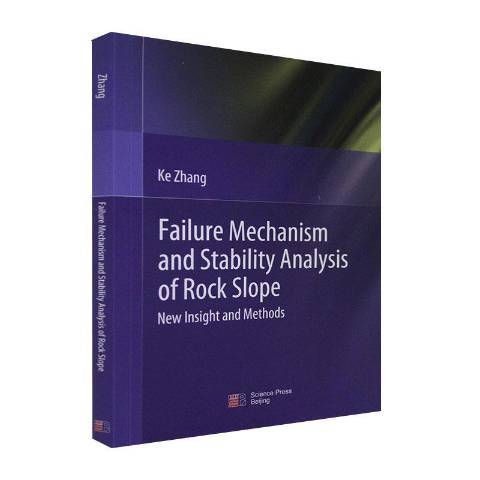內容簡介
圍繞複雜地質環境下高岩質邊坡安全控制問題,根據岩質邊坡失穩破壞模式,《複雜地質環境下岩質邊坡破壞機理及穩定性研究(英文版)》將坡體結構劃分為碎裂結構以及結構面控制型。綜合運用岩體力學、彈塑性力學、斷裂力學以及分形理論等多學科理論,遵循“地質概化、理論建模、試驗驗證、數值模擬、工程套用”的研究路線,依託我國露天礦、路塹以及庫區高陡邊坡工程,開展複雜地質環境下岩質邊坡破壞機理的基礎研究,揭示了不同坡體結構的岩質邊坡變形與穩定性動態演化特徵,構建了針對不同坡體結構的岩質邊坡性能綜合評價指標體系與評估方法。《複雜地質環境下岩質邊坡破壞機理及穩定性研究(英文版)》系統介紹了作者近年來在複雜地質環境下岩質邊坡破壞機理及穩定性研究方面所取得的學術成果。
圖書目錄
Contents
Preface
List of Figures
List of Tables
Chapter 1 Introduction 1
1.1 Background 1
1.2 Crack Propagation and Coalescence in Rocks 3
1.3 Numerical Methods of Rock Slope Stability Analysis 5
1.4 Main Contents in This Book 8
References 13
Part I Experimental Studies on Shear Failure Mechanism of Rock Masses
Chapter 2 Influence of Flaw Inclination on Shear Fracturing and Fractal Behavior 21
2.1 Experimental Studies 22
2.2 Patterns of Crack Propagation and Coalescence 25
2.3 Peak Shear Strength of Flawed Specimens 34
2.4 Fractal Characteristics of the Fragmentation 36
2.5 Conclusions 40
References 41
Chapter 3 Influence of Flaw Density on the Shear Fracturing and Fractal Behavior 43
3.1 Experimental Studies 44
3.2 Numerical Shear?Box Tests with the RFPA Model 50
3.3 Shear Fracturing Behavior of Rock Bridges 53
3.4 Fractal Characteristics of the Shear Fracture Surface 61
3.5 Conclusions 66
References 67
Part II Large-Scale, Global Failure Mechanism and Stability Analysis
Chapter 4 Empirical Methods for Estimating Strength Parameters of Jointed Rock Masses 73
4.1 Methods Relating Strength with RQD 74
4.2 Methods Relating Strength with Q 75
4.3 Methods Relating Strength with RMR 75
4.4 Methods Relating Strength with Hoek-Brown Failure Criterion and GSI 76
References 78
Chapter 5 Kinematical Element Method 80
5.1 Kinematical Element Formulation Subjected to Seismic Loading and Water 81
5.2 Numerical Studies and Verification 86
5.3 Blasting Effect on Slope Stability and Example Analysis 91
5.4 Seismic Stability Charts for Slopes 95
5.5 Rigorous Back Analysis 102
5.6 Reliability Analysis 111
5.7 Conclusions 115
References 116
Chapter 6 Integrated Karst Cave Stochastic Model-Limit Equilibrium Method 119
6.1 Engineering Background 121
6.2 A Monte Carlo Simulation to Generate a Karst Cave Stochastic Model 125
6.3 Integrated Methodology for Stability Analysis 131
6.4 Optimization Design of the Slope Angle 140
6.5 Conclusions 146
References 148
Chapter 7 Strain-Softening Behavior and Strength Reduction Method 151
7.1 Progressive Failure and Improved Strength Reduction Method 151
7.2 Numerical Study and Verification 155
7.3 Progressive Failure Analysis 160
7.4 Parameters Analysis 161
7.5 Application 164
7.6 Conclusions 166
References 167
Chapter 8 Three-Dimensional Effect and Strength Reduction Method 170
8.1 Three-Dimensional Effect of Boundary Conditions 172
8.2 Three-Dimensional Effect of Strength Parameters 176
8.3 Stability Charts for Three-Dimensional Slope 180
8.4 Three-Dimensional Effect of Concentrated Surcharge Load 190
8.5 Calculation Procedure for Slope Stability Analysis 194
8.6 Conclusions 195
References 196
Part III Structurally-Controlled Failure Mechanism and Stability Analysis
Chapter 9 Discontinuity Kinematical Element Method 201
9.1 Discontinuity Kinematical Element Formulation with Major Geological Discontinuities 202
9.2 Numerical Studies and Verification 206
9.3 Rock Slope with Non-Persistent Discontinuities 210
9.4 Application 214
9.5 Conclusions 216
References 217
Chapter 10 Joint Element and Strength Reduction Method 219
10.1 Engineering Background 220
10.2 Discontinuity Modelling in DDM 221
10.3 Modelling of Failure Initiation 227
10.4 Discontinuity Modelling in FLAC 3D 228
10.5 Modelling of Progressive Failure 231
10.6 Role of Joint Inclination on Slope Stability 237
10.7 Conclusions 240
References 242
Chapter 11 Fracture Mechanics Method 244
11.1 Engineering Background 246
11.2 Theoretical Formulation 251
11.3 Modelling Fracture Behavior 252
11.4 Role of Joint Geometry Parameters on Slope Stability 253
11.5 Evolution of Slopes Subject to Weathering 258
11.6 Conclusions 264
References 265
List of Figures
List of Figures
Fig.1.1 Guobu slope on the upper stream of Laxiwa dam 1
Fig.1.2 High rock slope in Shilu iron mine 2
Fig.1.3 Discontinuities in a rock slope 3
Fig.1.4 Two fundamental types of cracks 4
Fig.1.5 Failure mode of rock slope assumed by Sarma method 6
Fig.1.6 Three loading modes applied to a crack 8
Fig.1.7 Idealized diagram showing the influence of scale on the type of rock mass behavior 9
Fig.1.8 A large-scale, global failure in an open pit mine 9
Fig.1.9 Schematic diagram of structurally-controlled instability 10
Fig.1.10 A structurally-controlled failure in an open pit mine 10
Fig.2.1 Aishihik River landslide 21
Fig.2.2 Randa rockslide and test element modified after Eberhardt et al.(2004) 22
Fig.2.3 Geometry of the specimen containing mixed flaws 23
Fig.2.4 View of the specimens ready to be tested 24
Fig.2.5 Layout of the loading system 25
Fig.2.6 Stress states in the rock slope and the shear-box test 25
Fig.2.7 Patterns of tensile crack propagation observed i

